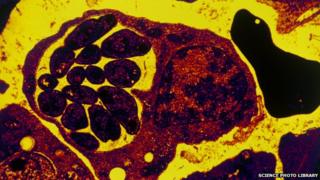
Image copyright Science Photo Library Image caption Malaria parasites – seen tightly packed in this red blood cell – have evolved resistance to artemisinin
The genetics underpinning resistance to a frontline malaria drug, artemisinin, have been revealed, scientists say.
In South East Asia, malaria parasites have developed tolerance to the treatment, and there are fears that this will spread.
Now, in the largest genetic study to date, scientists have identified mutations in the parasite genome that are linked to resistance.
The study is published in Nature Genetics.
The researchers say the findings will help them to identify areas where artemisinin resistance could spread.
Lead author Dr Olivo Miotto from the Mahidol-Oxford Tropical Research Unit (MORU), in Thailand, said: “Artemisinin is the best drug we have had for a very long time, and we want to continue this success story.
“And for that its effectiveness has to be protected and sustained.”
When the first malaria drug, chloroquine, was developed, researchers thought that the disease would be eradicated within years.
But the malaria parasite has proved far tougher than they ever imagined. Drug after drug has been rendered useless as the parasite has evolved to evade treatment.
Mysteriously, each time resistance has emerged, it has started in the same place – on the Cambodia-Thai border – before spreading across Asia and into Africa.
Now this appears to be happening again with artemisinin, a drug that has transformed malaria treatment.
Cases have been confirmed in Thailand, Cambodia, Laos, Vietnam and Myanmar, also known as Burma.
Now an international team of scientists have identified several mutations on genes in the malaria parasite that are linked to resistance.
After analysing 1,612 samples from 15 locations in Asia and Africa, scientists confirmed that mutations on a gene called kelch13 are strongly associated with malaria resistance.
“If you don’t have this mutation of kelch13, you don’t have resistance,” Dr Miotto told the BBC.
The researchers also found four other mutations that appear to work in concert with the kelch13 mutation.
Professor Dominic Kwiatkowski, head of the malaria programme at the Wellcome Trust Sanger Institute and professor of genomics and global health at Oxford University, said: “We found these other points that do seem to be variants that are particularly concentrated in South East Asia.
“And within South East Asia, the risk of a parasite developing a mutation in kelch13 is greatly enhanced if the parasite has these other variants.”
The researchers said that they did not yet fully understand the mechanism behind this, or exactly why these mutations are linked to one area of Asia.
But tracking down parasites that have these genetic changes could help them to identify the areas where resistance may spread.
“As a tool for mapping. if we know we have markers of resistance then that is good – and the kelch mutation is very helpful,” said Professor Dominic Kwiatkowski.
“It is quite an efficient way of mapping out where resistance is and isn’t.”
He added: “The other markers we have developed don’t tell us explicitly where resistance is, but they do tell us where resistance might be likely to develop in the future.
“In any attempts to eliminate malaria – you do have finite resources, and you have to work out where to spend those resources. And being able to map out where resistance exists and where it is likely to develop is incredibly useful in helping you focus your resources in eliminating malaria.”
Scientists fear that drug resistance could eventually spread to sub Saharan Africa, unless it is stopped.
The World Health Organization (WHO) says that measures to prevent and treat malaria there have halved the number of deaths from the disease there since 2000, but drug tolerance could be a major setback.
Follow Rebecca on Twitter
Genetics of malaria drug resistance revealed have 693 words, post on www.bbc.com at 2015-01-19 16:37:01. This is cached page on WBNews. If you want remove this page, please contact us.
